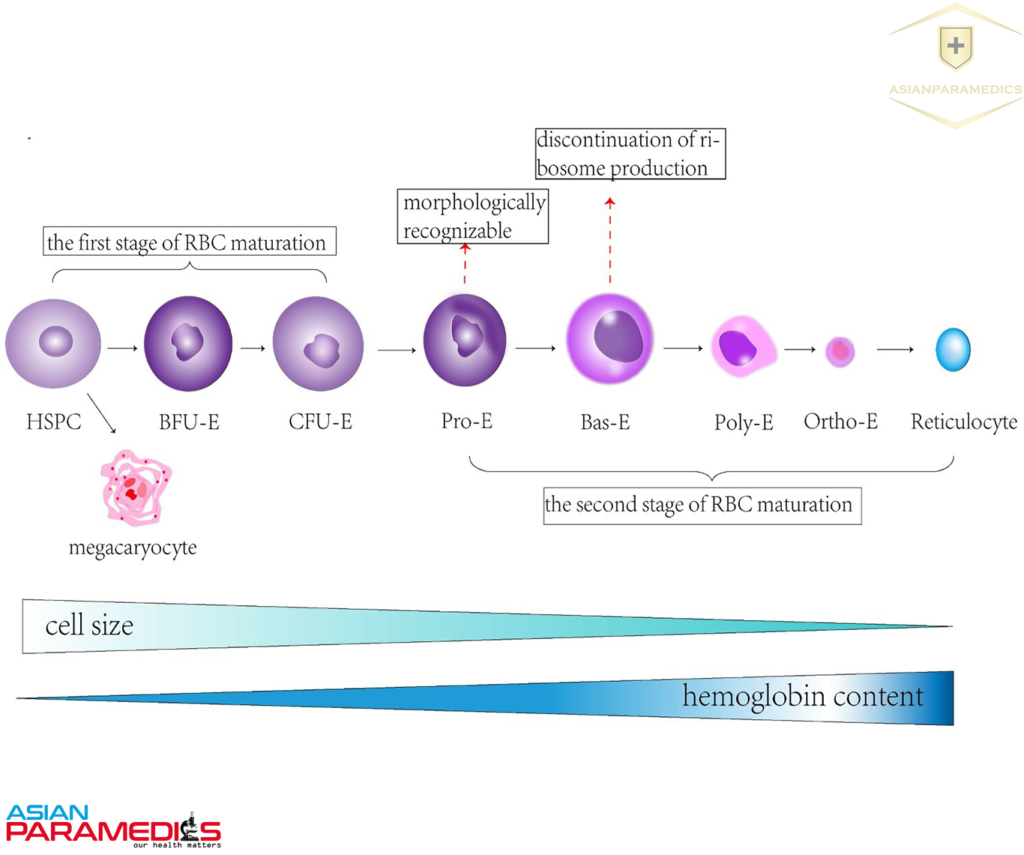ERYTHROPOIESIS
Erythropoiesis is the process of proliferationdifferentiation, and maturation of red blood cellunder the action of erythropoietin and other growth factors.
○ Erythropoiesis begins with the Pluripotent hematopoietic stem cell
○ Normally the process of proliferation and maturation is completed within 3-5 days
○ Stem cell differentiation is induced by microenvironmental influences to produce a committed erythroid progenitor cell
○ Committed erythroid progenitor cell is undergoes into several phases to become a mature red blood cell
○ With each developmental phases, there is decrease in the cell size, condensation of the nuclear chromatin, loss of nucleoli, gradual decrease in the basophilia and progressive increase in pink color of the cell due to hemoglobin synthesis
○ Mature red cell has no nucleus, ribonucleic acid and mitochondria
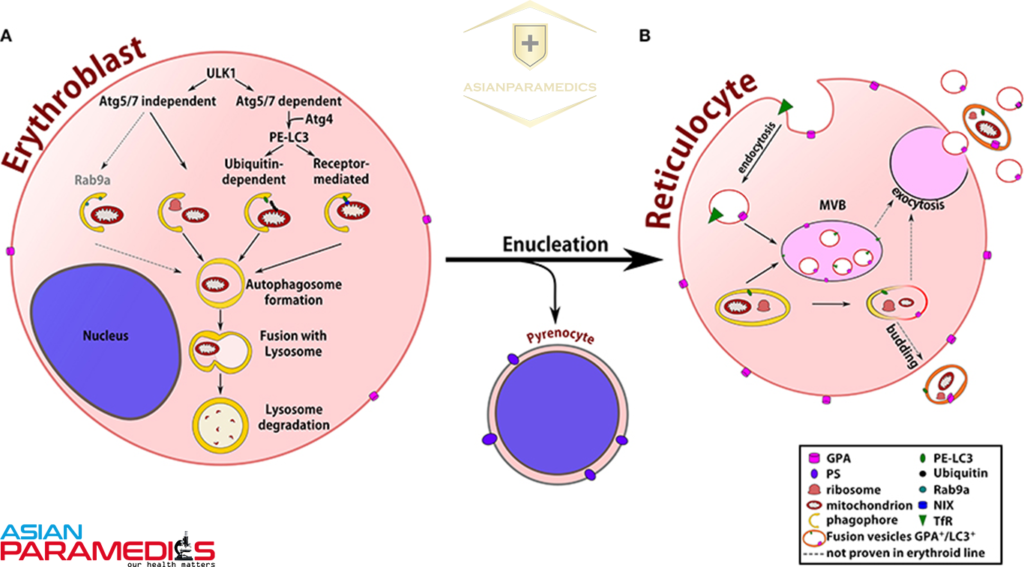
ERYTHROPOIESIS PROCESS
○ PHSC differentiate into BFU-E progenitor cell
○ The BFU-E progenitor cells proliferate under the influence of what was originally called “burst-promoting activity” (Release of cytokine IL-3 or GM-CSF, by local microenvironmental stromal cells)
○ The BFU-E progenitor have low EPO receptor and insensitive to EPO
○ BFU-E progenitor give burst or multifocal colony (several 100 to several 1000 BFU-E per colony)on cell culture in vitro assay in 10 to 14 days
○ The BFU-E progenitor cells is CD34 strong positive
○ It is differentiate into CFU-E and have more EPO receptors comparatively BFU-E
○ CFU-E stem cell loosing CD34 (Positivity) expression but begin to express surface proteins of the erythroid lineage
○ Including glycophorin A, Rh antigens, and in a subset of CFU-E, the ABH and Ii antigens
DEVELOPMENTAL STAGES
Morphologically erythropoiesis is divided into six (6) developmental stages:
1. Proerythroblast
2. Basophilic erythroblast
3. Polychromatophilic Erythroblast
4. Orthochromatic Erythroblast
5. Reticulocytes
6. Mature RBC
1. Proerythroblast (1%)
Cell size: Large (20-25 um), Shape: Round, N:C: High (8:1)
Cytoplasm:
Color: Deep blue with pallor area
Amount: Small or scanty
Granules or vacuoles: Absent
Nucleus:
Color: Radish purple
Nucleus location: Central
Chromatin Pattern: Open and homogenous
Nucleolus: 1-2 present
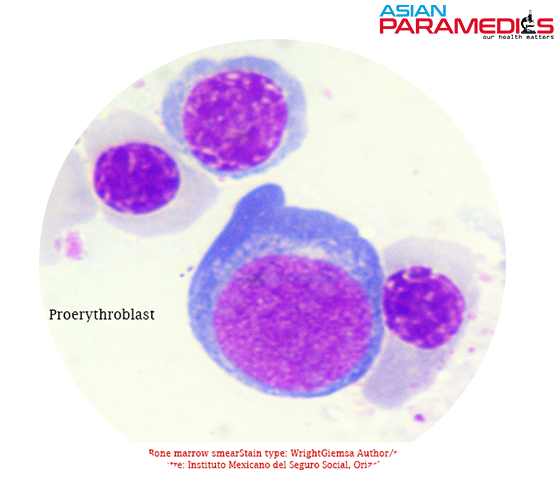
2. Basophilic Erythroblast (1-3%)
Cell size: Large (12-15 um), Shape: Round, N:C: Moderate (6:1)
Cytoplasm:
Color: Basophilic
Amount: Moderates
Granules or vacuoles: Absent
Nucleus:
Color: Deep purplish blue
Nucleus location: Central
Chromatin Pattern: Coarse
Nucleolus: may be present
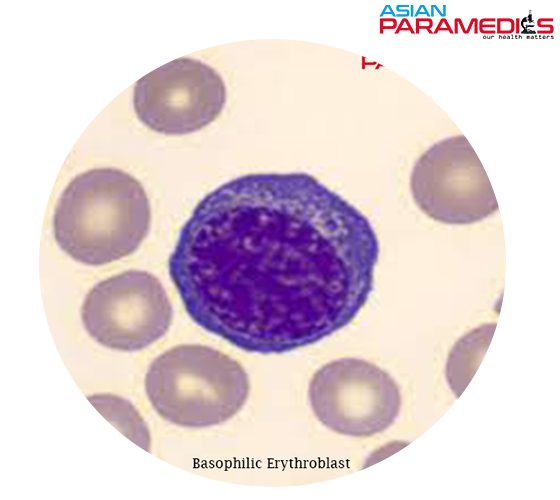
3. Polychromatophilic Erythroblast (13-30%)
Cell size: Large (12-15 um), Shape: Round, N:C: Low (4:1)
Cytoplasm:
Color: Gray blue with pallor area
Amount: Abundant
Granules or vacuoles: Absent
Nucleus:
Color: Deep purplish blue
Nucleus location: Eccentric or Central
Chromatin Pattern: Condensed
Nucleolus: Not present
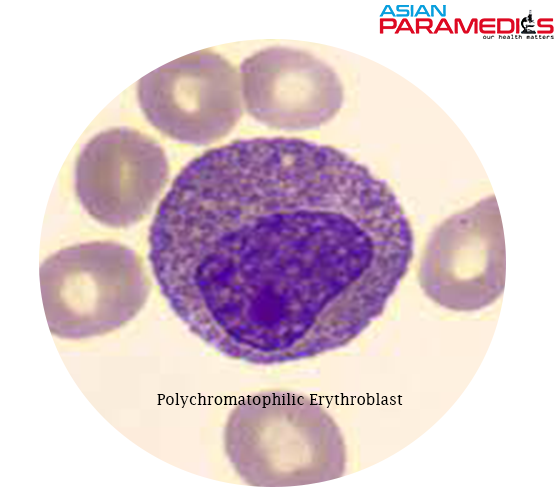
4. Orthochromatophilic Erythroblast (1-4%)
Cell size: Large (10-15 um), Shape: Round, N:C: Low (1:2)
Cytoplasm:
Color: Pinkish blue
Amount: Moderate
Granules or vacuoles: Absent
Nucleus:
Color: Deep purplish blue
Nucleus location: Eccentric, pyknotic round
Chromatin Pattern: Condensed/clumped
Nucleolus: Not present
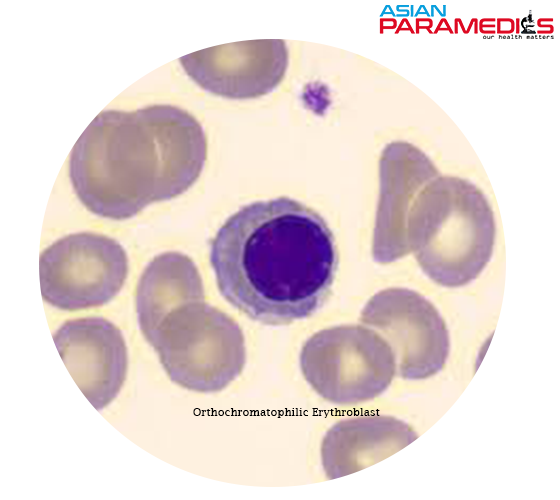
5. Reticulocytes (0.8-1.2%)
Size: Larger then mature RBC (7-10 um), Shape: Round,
Cytoplasm:
Color: Polychromatophilic on Romanowsky stains and blue color on BCB or new methylene blue stain Cytoplasm contain purplish-blue inclusions actually it is the remaining of RNA
Cytoplasm of the reticulocytes contain iron granules (pappenheimer bodies), nucleus remnants (Howell-jolly bodies), RER, polyribosomes, mitochondria and fragmented Golgi apparatus

6. Mature RBCs
Cell size: 7-8 um
Normal Range: Male: 4.5-5.5, Female: 3.5-4.5 mill/μL
It is in the shape of a flexible biconcave disc, a shape which is ideally suited to squeeze through the microcirculation in the body
Because of its shape and the surface characteristics it is best suited to carry on its function as a vehicle for the uptake, transport and delivery of oxygen
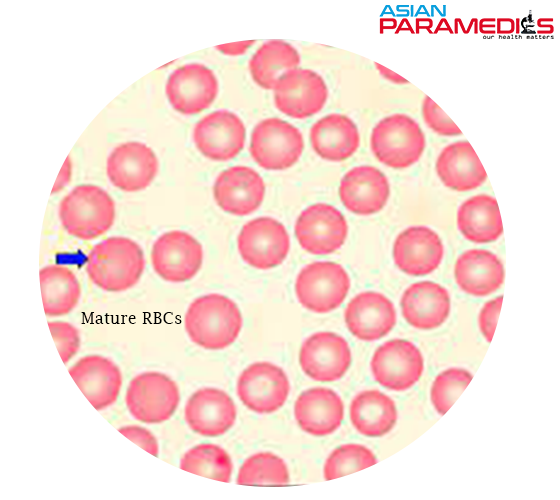
REGULATION OF ERYTHROPOIESIS
» Some cytokines have a positive effect on erythrocyte precursor proliferation include stem cell factor (SCF), thrombopoietin, and IL-11
» Some have negative effect on proliferation such as tumor necrosis factor a (TNFa), transforming growth factor-β (TGF β), and interferon-γ(INFγ)
» However erythropoietin (EPO) is the key regulator of erythropoiesis
» EPO is a thermostable renal glycoprotein hormone with a molecular weight of about 34,000 daltons
» Renal cortical interstitial cells secrete EPO in response to cellular hypoxia
» Conditions that stimulate erythropoiesis include anemia, cardiac or pulmonary disorders, abnormal hemoglobins, and high altitude

